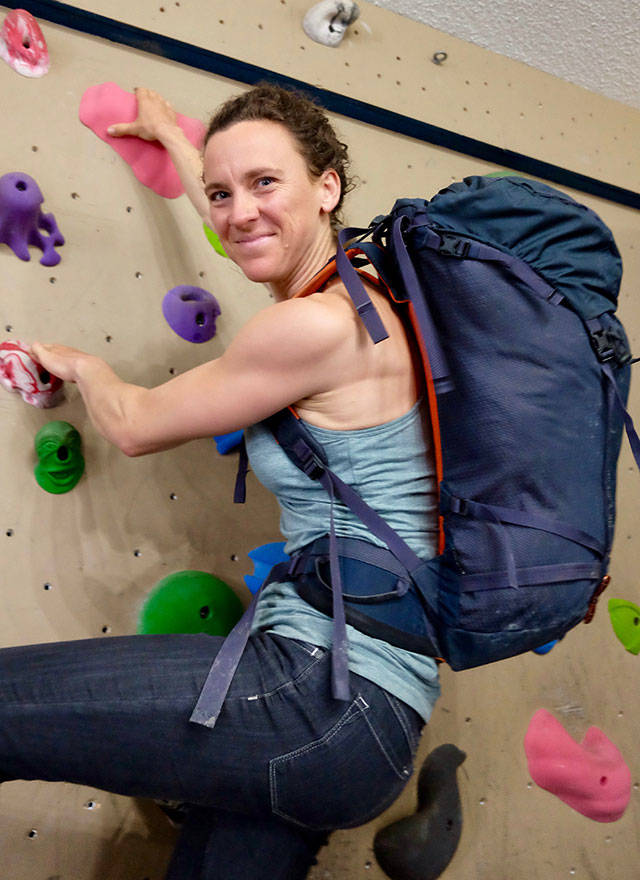Editor’s note: This is the third in a series titled “Tools of the Trade,” about things islanders use in their everyday work.
By Andy James
For The Beachcomber
Lyra Pierotti reviews climbing gear for money. She works as a certified rock and alpine guide, leading clients on 10-day expeditions or up near-vertical faces.
Anyone expecting her to sling a flashy backpack will be disappointed.
“I don’t consider myself a gear-head, which a lot of outdoor enthusiasts tend to be. I find I want something that is durable, is reliable, and that’s kind of it,” Pierotti said.
Pierotti’s van pops open and unfolds a bit like a device from Inspector Gadget. But her pack, a 38-liter Osprey Mutant, looks like a simple affair.
Pierotti explained the reason for the simplicity is because pack manufacturing has changed over the years, and climbers, specifically, view that trait as essential to the product.
“That gets away from backpacking models, which have really beefy suspension, and the really thick foam padding,” she said. “All of that really gets in your way when you’re trying to climb.”
Climbers rely on their core strength, and are increasingly looking for a minimal suspension that she describes as “very thin, very firm.”
“Your body has to get used to it over time. It also means that it sits very close to your back. In that way, it distributes loads and allows you to move more fluidly over variable terrain,” Pierotti said.
Climbers start living out of their packs the moment they leave the trailhead, Pierotti said. That might mean a day of “cragging” — going up and down a single pitch — or climbing eight to 12 hours per day for days over varied terrain.
“The backpack is probably the source of the most inspiration and frustration. It takes you all the way up to the biggest missions on the planet,” she said.
Despite its simple appearance, the Mutant has many features she relies on.
“I can put my ice tool on the backpack, and I can actually take it off without taking the backpack off,” Pierotti said, “so moving through changeable terrain, I can change my method of security quickly without having to take my backpack off.”
The pack can also be downsized, she added.
“A key part of alpine climbing is that you get everything as lightweight as you possibly can,” Pierotti said. “That means that I can take the lid of the backpack off and leave it behind at camp before the summit push.”
Unlike some climbers, Pierotti is not superstitious about her gear — although she admits that “when I was really little I used to wear my mom’s soccer cleats for good luck.”
Instead, she relies on analysis and planning to keep her backpack working for her.
“If I’m going out on my own personal big objective, the way that I pack my pack, and which one I select, can be a very, very measured calculation,” Pierotti said.
Miscalculations earlier in her career exacted a price. She had to take several months off of guiding after guiding Denali because she had so much compression in her spine from a pack that wasn’t distributing weight appropriately.
“[I had] cumulative overuse previously from another pack that was too small, that I used for a whole season just being kind of ignorant, or thinking I was gonna tough it out, and it’s a terrible, terrible idea,” Pierotti said.
When not in the field, Pierotti teaches climbing at the Recess Lab on Vashon. She passes on her analytical approach to gear to her students.
Still, she admits to some affection for the pack that has been her companion for a few years.
“When [your gear] wears out and they don’t make it anymore, that’s particularly heartbreaking,” Pierotti said. “It’s a very visceral connection you have with your gear.”
When a backpack “feels great,” she said, a lot of times climbers like her don’t give this kind of gear enough credit for getting them through expeditions.
“You just kind of forget about it. But when it feels terrible, you can remember ‘oh yeah, that was that climb where I had that pack, that was the worst climb of my life,’” Pierotti said.


